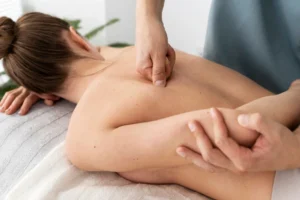 Rolfing and massage therapy are two distinct approaches to bodywork, each with its own techniques, goals, and benefits. While both modalities aim to promote relaxation and alleviate muscular tension, they differ in their underlying principles and methods.
Rolfing and massage therapy are two distinct approaches to bodywork, each with its own techniques, goals, and benefits. While both modalities aim to promote relaxation and alleviate muscular tension, they differ in their underlying principles and methods.
While massage therapy focuses on relieving muscular tension and promoting relaxation, Rolfing aims to create lasting changes in the body’s structural alignment and movement patterns.
Let’s explore what Rolfing is and how it differs from massage therapy.
Understanding Rolfing
Rolfing, also known as Structural Integration, is a form of bodywork developed by Dr. Ida Rolf in the mid-20th century. It focuses on realigning the body’s connective tissues, known as fascia, to improve posture, balance, and overall well-being. Rolfing practitioners use a series of hands-on techniques to release tension in the fascia and optimize the body’s structural alignment.
Key Principles of Rolfing
Holistic Approach. Rolfing views the body as a dynamic system of interconnected parts. Rather than treating isolated symptoms, Rolfing addresses the body as a whole, considering the relationship between different parts and structures.
Long-Term Structural Change. Unlike massage therapy, which often provides temporary relief from muscular tension, Rolfing aims to create lasting structural changes in the body. Through a series of sessions, Rolfing gradually reorganizes the body’s fascial network, promoting improved alignment and mobility.
Distinguishing Features of Rolfing
Focus on Fascia. Rolfing targets the body’s fascia, a network of connective tissues that surround muscles, bones, and organs. By releasing restrictions in the fascia, Rolfing helps restore balance and ease of movement throughout the body.
Series-Based Approach. Rolfing typically involves a series of 10 sessions, each focusing on different areas of the body. This systematic approach allows for progressive realignment and integration of the body’s structure, addressing underlying patterns of tension and imbalance.
Understanding Massage Therapy
Massage therapy involves the manipulation of soft tissues, including muscles, tendons, and ligaments, to promote relaxation, relieve muscular tension, and alleviate pain. Massage therapists use various techniques, such as Swedish massage, deep tissue massage, and trigger point therapy, to address specific areas of discomfort and promote overall well-being.
Key Principles of Massage Therapy
Muscle Relaxation. Massage therapy primarily focuses on relaxing the muscles and releasing tension held within the soft tissues. Techniques such as kneading, compression, and stretching help improve circulation, reduce muscular tightness, and promote relaxation.
Short-Term Relief. While massage therapy can provide immediate relief from muscular tension and discomfort, its effects are often temporary. Without addressing underlying structural imbalances, muscular tension may return over time.
Key Differences Between Rolfing and Massage Therapy
Scope of Treatment. Rolfing addresses the body’s structural alignment and fascial network, aiming to create long-term changes in posture and movement patterns. Massage therapy primarily focuses on relieving muscular tension and promoting relaxation.
Approach to Sessions. Rolfing sessions are typically part of a structured series, with each session building upon the progress made in previous sessions. Massage therapy sessions are often more flexible and can be tailored to address specific areas of concern.
Rolfing and massage therapy are distinct approaches to bodywork, each offering unique benefits and methods. Depending on your individual needs and goals, both modalities can play a valuable role in supporting overall health and well-being.
If you are near Tampa and would like to try Rolfing massage yourself, call Williams Rolfing. Living a pain-free life can become a reality when one focuses on the relationship between posture and health, thereby creating a body that is balanced with every motion.
Picture Credit: Freepik
